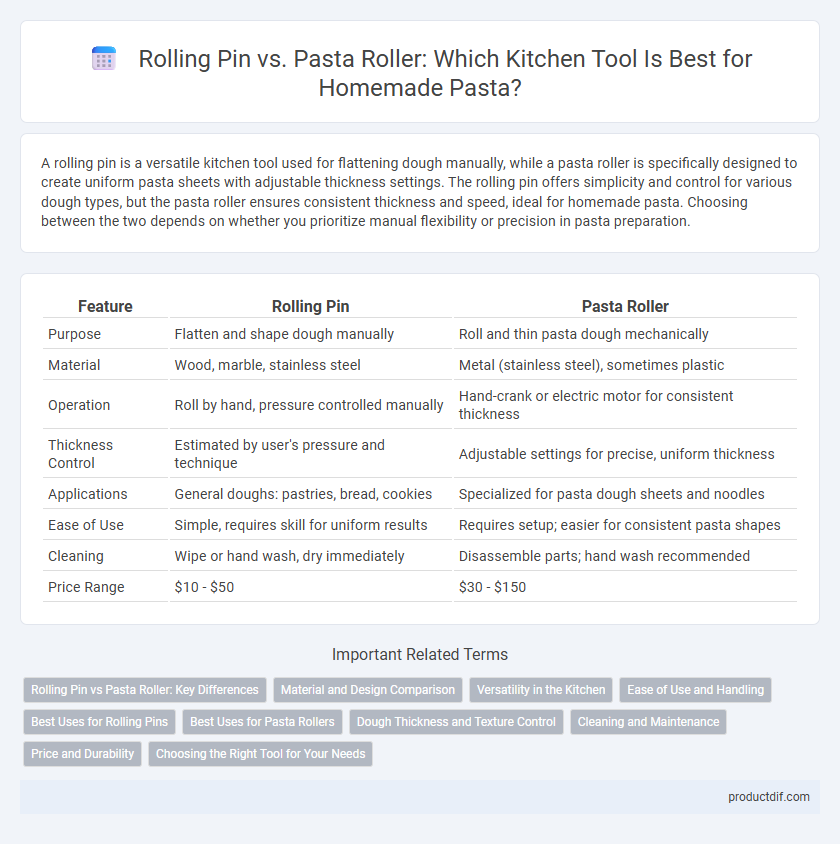A rolling pin is a versatile kitchen tool used for flattening dough manually, while a pasta roller is specifically designed to create uniform pasta sheets with adjustable thickness settings. The rolling pin offers simplicity and control for various dough types, but the pasta roller ensures consistent thickness and speed, ideal for homemade pasta. Choosing between the two depends on whether you prioritize manual flexibility or precision in pasta preparation.
Table of Comparison
| Feature | Rolling Pin | Pasta Roller |
|---|---|---|
| Purpose | Flatten and shape dough manually | Roll and thin pasta dough mechanically |
| Material | Wood, marble, stainless steel | Metal (stainless steel), sometimes plastic |
| Operation | Roll by hand, pressure controlled manually | Hand-crank or electric motor for consistent thickness |
| Thickness Control | Estimated by user's pressure and technique | Adjustable settings for precise, uniform thickness |
| Applications | General doughs: pastries, bread, cookies | Specialized for pasta dough sheets and noodles |
| Ease of Use | Simple, requires skill for uniform results | Requires setup; easier for consistent pasta shapes |
| Cleaning | Wipe or hand wash, dry immediately | Disassemble parts; hand wash recommended |
| Price Range | $10 - $50 | $30 - $150 |
Rolling Pin vs Pasta Roller: Key Differences
A rolling pin is a versatile kitchen tool primarily used to flatten dough manually, offering control over thickness with simple back-and-forth motions. In contrast, a pasta roller is a specialized device designed to consistently roll and thin pasta dough to precise thicknesses, often featuring adjustable settings and rollers. While a rolling pin suits general baking tasks, a pasta roller enhances efficiency and uniformity specifically in pasta-making.
Material and Design Comparison
Rolling pins are typically made from solid wood, marble, or silicone, offering a straightforward cylindrical design that allows for manual pressure control and versatility across various dough types. Pasta rollers, often crafted from stainless steel with adjustable thickness settings, feature a mechanized, dual-roller design for consistent, uniform sheets of pasta dough. The durable materials and precision engineering of pasta rollers provide enhanced efficiency and repeatability compared to the traditional, tactile experience of wooden or silicone rolling pins.
Versatility in the Kitchen
A rolling pin offers versatile use for flattening doughs, crushing nuts, and shaping pastries, making it essential for various baking and cooking tasks. Pasta rollers specialize in producing uniform pasta sheets with adjustable thickness settings, streamlining pasta making but with limited applications beyond dough preparation. Choosing between the two depends on whether broad kitchen utility or specific pasta crafting efficiency is the priority.
Ease of Use and Handling
Rolling pins offer straightforward handling and require minimal setup, making them ideal for quick tasks and beginners. Pasta rollers provide adjustable thickness settings and uniform dough flattening but involve more components, which can require practice to master. For ease of use, a rolling pin excels in versatility, while pasta rollers deliver precision with slightly more handling complexity.
Best Uses for Rolling Pins
Rolling pins excel at evenly flattening dough for pies, cookies, and pastries, offering precise control over thickness. Their cylindrical design makes them ideal for small to medium-sized dough portions, especially in home baking scenarios. Unlike pasta rollers, rolling pins provide versatility for various dough textures and shapes beyond pasta preparation.
Best Uses for Pasta Rollers
Pasta rollers are designed to create uniformly thin sheets of pasta dough, making them ideal for preparing lasagna, ravioli, and fettuccine with consistent thickness and texture. Unlike rolling pins, pasta rollers save time and effort by automating the flattening process, allowing for precise control over dough thickness through adjustable settings. Their best use is in achieving professional-level pasta shapes and thicknesses, especially for intricate or layered pasta recipes.
Dough Thickness and Texture Control
A rolling pin provides flexible control over dough thickness through manual pressure, allowing for varied texture based on user technique. Pasta rollers feature adjustable settings for consistent dough thickness, ensuring uniform texture ideal for precise pasta shapes. Choosing between the two depends on whether texture customization or thickness uniformity is the priority in dough preparation.
Cleaning and Maintenance
Rolling pins are typically easier to clean as they often consist of a single piece of wood or marble, requiring simple wiping or hand washing without submerging in water to prevent warping. Pasta rollers, with their metal components and intricate rollers, demand thorough cleaning after each use to remove flour and dough residues, often necessitating disassembly and drying to avoid rust and ensure smooth operation. Proper maintenance of pasta rollers includes regular oiling of mechanical parts, while rolling pins usually require periodic seasoning if wooden, to maintain the surface and prevent cracking.
Price and Durability
Rolling pins are generally more affordable, with prices ranging from $10 to $30, while pasta rollers typically start around $40 and can exceed $150 depending on brand and features. In terms of durability, stainless steel or wooden rolling pins can last decades with proper care, whereas pasta rollers, often made of metal with moving parts, require more maintenance but offer long-term use when well-maintained. Choosing between the two depends on budget constraints and the frequency of use, as pasta rollers provide precision at a higher initial investment.
Choosing the Right Tool for Your Needs
Selecting the right kitchenware depends on your culinary goals: a rolling pin offers versatility for rolling dough of various types and thicknesses, while a pasta roller provides consistent, uniform sheets specifically designed for pasta making. Rolling pins are ideal for general baking tasks, including pastries and cookies, while pasta rollers excel in shaping and thinning fresh pasta dough with precision. Understanding your cooking frequency and recipe requirements ensures choosing the optimal tool that balances functionality with convenience.
Rolling Pin vs Pasta Roller Infographic

 productdif.com
productdif.com